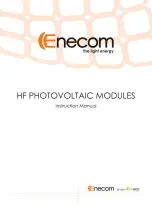
Yingli Solar PV Modules, Installation and User Manual
page 1
This manual applies to photovoltaic modules (“PV modules”,
also commonly known as solar panels) manufactured by
Yingli Energy (China) Co., Ltd. (“Yingli Solar”), and is explicitly
written for qualified professionals (“Installer” or “Installers”),
including without limitation licensed electricians and RAL
Certified PV Installers.
I N T R O D U C T I O N
Thank you for choosing Yingli Solar as your PV module provider. We
appreciate your business! This manual contains important information
pertaining to the electrical and mechanical installation and maintenance
of PV modules, and contains safety information that you must read carefully
and be familiar with before handling, installing, and/or maintaining Yingli Solar
PV modules.
Yingli Solar does not assume responsibility and expressly disclaims liability for
losses, damages, or expenses arising out of, or in any way connected with this
Installation and User Manual. Yingli Solar assumes no responsibility for any
infringement of patents or other rights of third parties, which may result from
using Yingli Solar PV modules. No license is granted expressly or by implication
or under any patent or patent rights. The information in this manual is believed
to be reliable, but does not constitute an expressed or implied warranty. Yingli
Solar reserves the right to make changes to its PV modules and other products,
their specifications, or this manual without prior notice.
Yingli Solar and its subsidiaries are not liable for any damages caused by
inappropriate installation, use, or maintenance of Yingli Solar PV modules,
including without limitation damages, losses, and expenses caused by non-
observance of the instructions of this manual or caused by or in connection with
products of other manufacturers.
Yingli Solar PV modules are designed to meet the requirements for the standards
IEC 61215 and IEC 61730, application class A. Modules rated for use in this
application class may be used in systems operating at greater than 50 V DC
or 240 W, where general contact access is anticipated. Modules qualified for
safety through IEC 61730-1 and IEC 61730-2 and within this application class are
considered to meet the requirements for safety class II. In the course of the PV
module certification process, the compliance of this manual with the certification
requirements has been verified by an independent certification laboratory.
This Installation and User Manual is available in different languages. In cases of
discrepancy between versions, the English language version shall control.
Failure to comply with the requirements listed in this manual will invalidate the
Limited Warranty for PV Modules as provided by Yingli Solar at the time of sale
to the direct customer. Additional recommendations are provided to enhance
safety practices and performance results. Please provide a copy of this manual
to the PV system owner for their reference, and inform them of all relevant
aspects of safety, operation, and maintenance.
S A F E T Y
General
You must understand and follow all applicable local, state, and federal
regulations and standards for building construction, electrical design, fire,
and safety, and must check with local authorities to determine applicable
permitting requirements before attempting to install or maintain PV modules.
Rooftop PV systems should only be installed on dwellings that have been
formally analyzed for structural integrity, and confirmed to be capable
of handling the additional weighted load of PV system components,
including PV modules, by a certified building specialist or engineer.
For your safety, do not attempt to work on a rooftop until
safety precautions have been identified and taken, including
without limitation fall protection measures, ladders or
stairways, and personal protective equipment (PPE).
For your safety, do not install or handle PV modules under adverse conditions,
including without limitation strong or gusty winds, and wet or frosted roof surfaces.
The flat-plate PV module construction consists of a laminated assembly
of solar cells encapsulated within an insulating material with a rigid
glass surface and an insulated substrate. The laminated assembly is
supported by an aluminum frame that is also used for mounting the
module. See Figure 1 for an illustration of the PV module components.
Figure 1: Module components and cross-section of the laminated assembly
Electrical
PV modules can produce current and voltage when exposed to
light of any intensity. Electrical current increases with higher
light intensity. DC voltage of 30 Volts or higher is potentially
lethal. Contacting the live circuitry of a PV system operating
under light can result in lethal electric shock.
Junction Box
Cable
Connector
Cell
Frame
1
1.
Aluminum Frame
2. Glass
3. Encapsulating EVA
4. PV Cell
5. Backsheet
2
3
5
4
Y I N G L I S O L A R . C O M
YINGLI SOLAR PV MODULES
Installation and User Manual
Revision date Nov. 17, 2020 | Applicable for IEC certified products
File name: Corporate Logo with Tagline / Vertical.ai


























